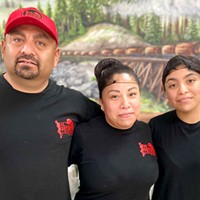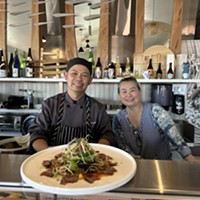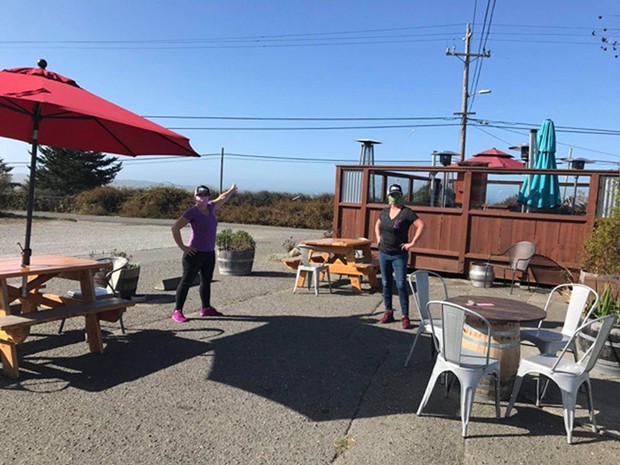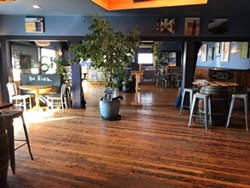Pouring in a Pandemic
Rules for reopened bars and advice from bartenders
By Jennifer Fumiko Cahill [email protected] @jfumikocahill[
{
"name": "Top Stories Video Pair",
"insertPoint": "7",
"component": "17087298",
"parentWrapperClass": "fdn-ads-inline-content-block",
"requiredCountToDisplay": "1"
}
]
Even in Humboldt County's enviable seat in the yellow/minimal risk zone of California COVID-19 safety tiers, reopening bars doesn't mean we're back to body shots and plaza crawls. (Maybe we shouldn't bring back body shots.) Some of the things we miss about bars — the crowd, shouting over the music, huddling together over drinks — make them dangerous in a pandemic. Likewise, a couple rounds in and we tend to talk louder and relax about personal space, both of which researchers agree mean greater risk of spreading the virus.
In order to reopen, bars that don't serve food are required to follow similar sanitizing and social distancing guidelines to restaurants in order to reduce the inherent risks of removing your mask in public to drink with other people. There are compliant setups and protocols you can look for should you decide to walk into a bar, as well as friendly advice from experienced local bartenders you can follow to keep the staff safer and happier, too.
The Centers for Disease Control is clear about the risks of drinking and dining businesses. Highest risk is indoor seating — for both patrons and staff — due to the contained space in which you're lingering along with potentially virus-laden droplets and aerosols emitted through talking with folks who have masks off to drink. Lower risk is outdoor seating, as there is more air circulation to disperse those aerosols. Lowest is grabbing Mason jar cocktails and growlers to go. (Another benefit of a home-based buzz, of course, is you don't need to find a ride from your couch.)
The Shanty in Eureka is making the most of its patio, which is getting an awning for the winter, and not serving indoors at all right now, according to bartender Mike Vitiello. "Out back, we just have a specific amount of seats ... once all our seats are full, they're full," he says. Limited seating maintains the required reduced capacity as well. State guidelines for the yellow tier require capping the number of patrons at 50-percent capacity, which is not always easy to eyeball. What you can see easily, however, is whether those customers are wearing masks when not seated and drinking at their tables. All staff need to be masked, too. "It's a little tedious but it's necessary," Vitiello says, adding that while the occasional out-of-towner might need the rules explained, regulars know the deal. "We have the crowd that appreciates that we are following the rules. That's our clientele."
Cal/OSHA guidance for restaurants, bars and wineries states they must "discontinue seating customers and/or groups at bar counters, sushi preparation bars, etc., where they cannot maintain at least 6 feet of distance from work areas/stations." Gini Noggle, a bartender at Six Rivers Brewery who's also worked at Mad River Brewing Co. and Everett's, says there's good reason for nixing counter seating. "It's really up close. It would be hard to maintain 6 feet of distance ... it's crowded back there," she says. Instead, the bar top is covered with some items that have found popularity in the pandemic: Jell-O shots, locally made masks, local wine and a slushie machine that cranks out Frosé and other boozy frozen concoctions. Noggle appreciates the care the owners put into the setup. "Meredith [Maier] and Talia [Nachshon Clare] have been on top of everything. ... They've always put the safety of the staff first," she says.
While Noggle says staff at the brewery are regularly asked for input on safety, not every bartender in the business is. And while the staff shuttling drinks are most visible, they're not always making decisions about where to seat patrons or how to manage — or ignore — other safety protocols. Others the Journal has spoken to felt raising concerns might jeopardize their employment.
So if you do decide to drink at a local watering hole, take a bartender's advice — they're professionals at giving it out, after all. Noggle says before you roll in like you always have, stop and read. Reconfiguring a bar or restaurant for reduced contact sometimes means shifting whether you seat yourself and where you order and pay. "A lot of places have to tell you where to go," and often directions are posted up front. "I just ask wherever I go in now," she says. Also, "Go in wearing a mask, that'd be great ... an actual mask. It's been eight months and everyone should have one by now."
Vitiello counsels patience. "I understand we all need a little of a stress reliever and that's what the bar is there for," he says. "I didn't concoct a virus and I didn't make any rules." He recommends being patient with a staff that's likely adjusting to major changes in their jobs at bars that have already taken financial hits due to the pandemic. "We're trying to give you a good time — how about making it both ways? And if the rules are difficult to follow, maybe going out is not the best for you."
Asked what he does when he visits bars, Vitiello says he isn't going out. He figures he gets "enough exposure" at work.
. Reach her at 442-1400, extension 320, or [email protected]. Follow her on Twitter @JFumikoCahill.
Speaking of...
-

Mexican Restaurants Support English Express for Cinco de Mayo<
May 2, 2024 -

Look Up for Rooftop Sushi
Apr 19, 2024 -

On the Jamwagon Bandwagon
Apr 3, 2024 - More »
more from the author
-
Failed Leadership
- May 2, 2024
-
Mexican Restaurants Support English Express for Cinco de Mayo<
- May 2, 2024
-
Hole Food
- Apr 27, 2024
- More »



































